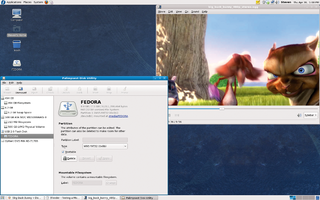
The Red Hat--sponsored Fedora Linux is a favorite with developers, admins, and end users around the world. This month's DVD includes 32- and 64-bit versions of the recently released Fedora 11. The latest Fedora comes with improved video card support, simplified fingerprint authentication, and a unified volume control interface. According to the Fedora project, "Fedora 11 offers a very good technical preview of features that may appear in the upcoming version of Red Hat Enterprise Linux."
| Highlights |
|
Linux Kernel 2.6.29 Gnome 2.26 KDE 4.2 RPM 4.7 GCC 4.4 Xfce 4.6 Windows cross-compiler PulseAudio volume control Fingerprint Firefox 3.5 NetBeans 6.5 Python 2.6 Thunderbird 3 Xserver 1.6 Presto |
| System Requirements |
|
Processor: Pentium class; Graphics mode, 400MHz or better; Text mode, 200MHz or better. Memory: Graphics mode, 348MB min/512MB recommended; Text mode, 256MB. Hard Disk: The necessary disk space varies depending on configuration and installation options. |
| Additional Resources |
|
[1] Fedora project: http://fedoraproject.org/ [2] Fedora 11 Release Notes: http://docs.fedoraproject.org/release-notes/f11/ [3] Fedora 11 Installation Guide: http://docs.fedoraproject.org/install-guide/ [4] Fedora Forum: http://fedoraforum.org/ |
| DVD Boot |
|
Place this DVD in the drive and restart your system. If your computer doesn't start, make sure your BIOS is configured to boot from a DVD. Enter the BIOS setup menu (see your vendor documentation), make sure DVD boot is enabled, and make sure the DVD drive appears before the hard drive in the boot order. |
| Double-sided DVD |
|
This DVD is a double-sided disc. A DVD device always reads the side of the disc that is facing down. This DVD is labeled like a normal DVD - the label you see as you place the disk into the tray applies to the data on the opposite side. For instance, if you are installing the 32-bit version, the 32-bit label should be facing up in the tray. |